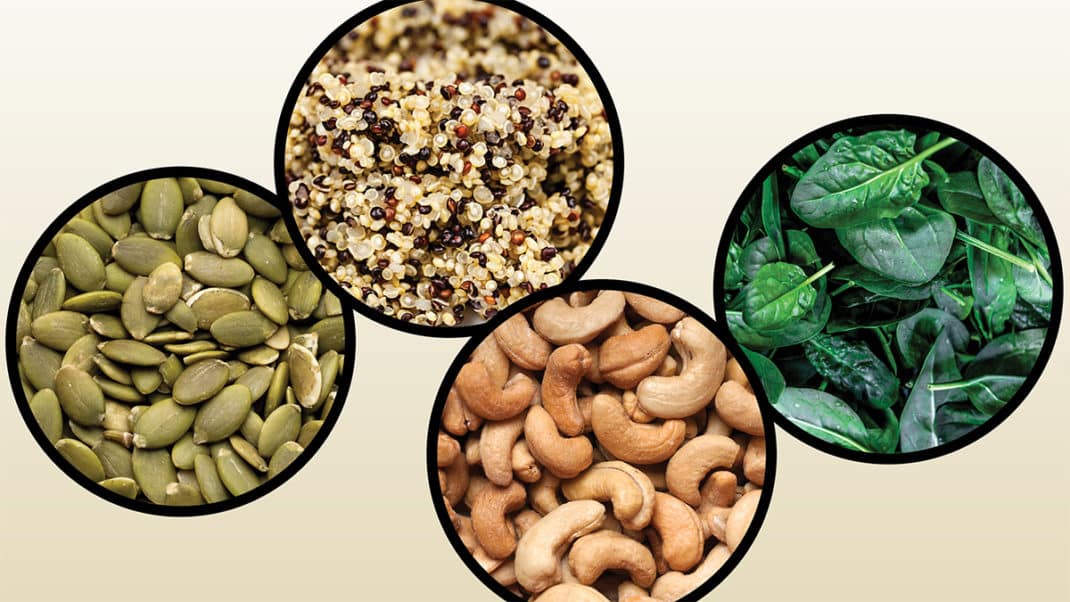Understanding the Role of Omega-3 & Omega-6 Fatty Acids
Recent findings make it clear: Not all fat is created equal.
Fat. Often the mention of this little word Triggers fear in the hearts and minds of people trying to manage their weight—and of those concerned with heart health and cancer prevention. But despite the list of charges against fat, some fatty acids are quite necessary and even healthy, serving important and possibly protective functions in the human body. What’s more, since the body is unable to synthesize some fatty acids “in house,”
we need to ingest them in our diet, which makes them “essential” nutrients. Two families of essential fatty acids (EFAs) are omega-3 (n-3) and omega-6 (n-6).
The most prominent n-3 family member is alpha-linolenic acid (ALA), which is found in green, leafy vegetables; nuts; beans; and flaxseed and canola oils. Eicosapentaenoic acid (EPA) and docosahexaenoic acid (DHA) are also n-3 fatty acids; they are found in fish and fish oils and, in addition, can be produced by ALA. Linoleic acid (LA), the main n-6 EFA, is found in grains; meats; seeds; and various oils, including corn, safflower, cottonseed and sunflower (Covington 2004). Many oils, including soybean and walnut, contain a mix of n-3 and n-6 types.
Both n-3 and n-6 EFAs act as precursors to hormone-like substances called eicosanoids. These eicosanoids—prostaglandins, thromboxanes and leukotrienes—are created from n-3 and n-6 EFAs and play vital roles in vascular physiology (Shahidi & Miraliakbari 2004). Eicosanoids that originate from the n-3 family tend to
- decrease the inflammatory response;
- inhibit blood clotting; and
- promote blood vessel dilation.
On the contrary, n-6 EFAs, especially arachidonic acid (AA), are precursors for eicosanoids that
- increase inflammation;
- increase blood clotting; and
- raise blood pressure.
Both n-3 and n-6 fatty acids serve important purposes; the trouble is that they fight with each other for the enzymes needed to create their respective eicosanoids. A fine balance of n-6 and n-3 in the diet, or a 1:1 ratio, is ideal to give both a chance to perform their necessary functions (Covington 2004). Unfortunately, the typical American diet is n-6 heavy, with an estimated 10:1 ratio (Covington 2004), because of the high intake of n-6-rich corn, safflower, sunflower and cottonseed oils from processed and fried foods. While the proper ratio between n-3 and n-6 is still pertinent, recent research suggesting that absolute amounts of n-3 EFAs may have a positive influence on health (Mozaffarian et al. 2005) highlights the need for further investigation.
EFAs and Immune Response
As mentioned, n-3 EFAs promote the formation of eicosanoids responsible for reducing inflammation. Because they act as anti-inflammatory agents, these EFAs have received attention from researchers interested in the prevention and treatment of conditions associated with some autoimmune diseases and illnesses associated with elevations in the inflammatory immune response. Such conditions include inflammatory bowel disease, arthritis, organ transplant, bronchial inflammation and type 1 diabetes mellitus (Shahidi & Miraliakbari 2005). The investigations reveal that the benefits of the n-3 group, and specifically of EPA, stem from its ability to oppose the potent pro- inflammatory eicosanoid AA (Stephensen 2004). In addition, n-3 EFAs suppress pro-inflammatory components of the immune response, such as interleukin-1 and tumor necrosis factor (Simopoulos 2002).
The “Eskimo Paradox”
In the 1950s, researchers began scratching their heads over the low incidence of heart disease in the dietary-fat-fond Inuit population of Greenland compared with the high rates among Danish settlers who consumed a lower-fat diet (Shahidi & Miraliakbari 2004). The Inuits also made headlines in the 1970s, when—to the chagrin of “Say no to dietary fat” advocates—new data emerged that again showcased their high-fat diet and low rate of coronary heart disease (CHD) (Moyad 2005). These findings sparked investigations into the notion that not all fat is created equal. What resulted was recognition that n-3 EFAs, especially EPA and DHA, are our dietary friends. In fact, the EPA and DHA found in fish and fish oils may help prevent cardiovascular disease (CVD) and other disorders.
EFAs and Heart Protection
Still weighing in as the number-one killer of men and women, CVD has caught and held the attention of U.S. health officials. Fortunately, n-3 EFAs have proven influential in the prevention of risk factors associated with CVD. Studies conducted over the last 10+ years have tied the intake of n-3 EFAs to a lower incidence of heart attack, cardiac arrhythmias and high blood lipid counts (Moyad 2005). One meta-analysis of randomized, controlled trials revealed that n-3 fatty acids decreased CHD, mortality from a second heart attack, and sudden death (Bucher et al. 2002). Although the amount and source of n-3 EFAs varied in the studies reviewed, the protective effects were statistically significant and, according to the study authors, n-3 warrants consideration as a treatment modality.
Data from the Nurses’ Health Study reflected a similar decline in CHD risk among women who consumed n-3 EFAs (Hu et al. 2002). Researchers studied the dietary consumption of 84,688 female nurses between 1980 and 1994. A comparison of the consumption of n-3 EFAs and CHD incidence revealed a protective effect from fish consumption and overall n-3 EFA intake.
The Nurses’ Health Study data were also analyzed to assess the relationship between risk of stroke and the consumption of fish and other sources of n-3 EFAs (Iso et al. 2001). Results showed an inverse relationship between n-3 intake and risk of thrombotic infarction in those who did not take a regular aspirin. (Aspirin’s ability to reduce blood clotting is greater than the ability of n-3 to do so and therefore overshadows the effects of n-3.) Overall, total stroke risk was reduced in those who consumed fish and other sources of n-3 EFAs.
The benefits of n-3 EFAs cannot be explained through one mechanism; nor have the mechanisms been completely described. What is known is that the benefits are multifactorial, and the mechanisms involved may include antiarrhythmic powers that reduce susceptibility to malignant arrhythmias; anticlotting effects that decrease atherogenesis; and anti-inflammatory properties—all of which lead to a protected heart (Moyad 2005; Shahidi & Miraliakbari 2004).
EFAs and Cancer
Dietary fat has long been linked to cancer development. Recent research has focused on the protective effects of n-3 EFAs in the development and treatment of a variety of cancers, and on n-6 EFAs as possible cancer promoters. The anti-inflammatory effect exhibited by the n-3 group may assist in reducing cancer development (Moyad 2005). In one study, this effect was investigated in relation to the development of colon tumors (Dwivedi, Natarajan & Matthees 2005). Researchers fed rats diets with either corn oil or ALA-rich flaxseed oil while administering a carcinogenic agent that causes colon cancer initiation. A colon tumor developed in 100% of the rats consuming corn oil—and only 54% of those given the flaxseed oil. The rats in the flaxseed group that did develop tumors developed significantly smaller ones than the rats that were fed corn oil. Upon further analysis, high levels of AA were identified in the colons of the corn oil group, suggesting that the AA metabolism to prostaglandins promoted tumor development (Dwivedi, Natarajan & Matthees 2005).
EFAs and Osteoporosis
Although we typically think of encouraging the intake of calcium and vitamin D for the prevention of osteoporosis, evidence suggests that EPA and DHA may also play a role. Research is sparse to date, but more investigation is warranted, since animal studies have revealed an association between a reduction in the n-6:n-3 ratio and an increase in both bone strength and the number of bone marrow cells (Moyad 2005). In addition, a recent study published in the American Journal of Clinical Nutrition evaluated the n-6:n-3 ratio and bone mineral density in 1,532 men and women (Weiss et al. 2005). Subjects’ bone scan results showed a correlation between a reportedly high n-6:n-3 ratio and low bone density in the hip region. This novel study exposes a need for further investigation and, possibly, a shift in the typical American diet.
Eating Your EFAs
The American Heart Association (AHA) recommends consuming fatty fish like mackerel, lake trout, herring, sardines, albacore tuna and salmon at least twice a week (AHA 2002; AHA 2005a). (For information about the dangers of the much-publicized mercury content of fish, see “Fish Safety” on page 64.) In addition to fishy options, AHA promotes the consumption of sources of ALA, such as soybeans, canola oil, walnuts and flaxseed. (For AHA-recommended quantities and food choices, see “How Much Omega-3?,” left.)
It is quite clear that a diet that emphasizes n-3 EFAs over n-6 EFAs promotes health and may prevent disease. The challenge is, how do we make this shift as seamless as possible to support adherence? And what do we advise clients who do not eat fish? Researchers out of Australia investigated a practical approach to increasing dietary n-3 EFAs (Metcalf et al. 2003). Subjects were given a wide variety of food choices to increase the n-3 fats in their diet while reducing the n-6 fats. Foods ranged from EPA- and DHA-rich fish to flaxseed, fortified luncheon meats, sausages, and margarines made from olive oil. Subjects were encouraged to eat as they chose—as long as they included the suggested foods in their diet. They were not advised to eat a particular amount or choose specific items. Results showed that subjects were able to increase their n-3 intake to the recommended 200–400 milligrams a day through everyday food items (Metcalf et al. 2003). Subjects who did not habitually eat fish were still able to achieve adequate levels of n-3.
Because so many people do not regularly consume fish—whether because of taste preferences, where they live or the season—the effect of n-3 enrichment in various foods has been examined. Mantzioris and colleagues (2000) provided subjects with common foods enriched with ALA, EPA and DHA. As in the Metcalf study, subjects achieved beneficial levels of these n-3 fatty acids, with a notable decrease in inflammatory markers after just 4 weeks. Researchers expressed confidence that enrichment can be a healthy alternative for people who are not regular fish eaters.
The bottom line? As long as clients strive for a balanced n-6: n-3 ratio by emphasizing sources of n-3 essential fatty acids in their diets, fat does not have to be a dirty word.
This section of the article is still in the process of conversion to the web.
The American Heart Association has provided the following guidelines for n-3 in the diet both for healthy people desiring to reduce their coronary heart disease (CHD) risk and for those with known disease.
If You Do Not Have CHD
Consume a variety of fatty fish at least twice a week. Include foods rich in alpha-linolenic acid, such as flaxseed, canola and soybean oils; and flaxseed and walnuts.
If You Do Have CHD
Consume a combined total of 1 gram of eicosapentaenoic acid (EPA) and docosahexaenoic (DHA) acid per day (preferably from fish). Supplement only under a physician’s care.
If You Have High Triglycerides
Consume a combined total of 2–4 grams of EPA and DHA per day under a physician’s care.
Source: Adapted from www.americanheart.org.
Concern regarding mercury and methylmercury levels in fish prompted an advisory report by the federal government in 2004 (U.S. Department of Health and Human Services & U.S. Environmental Protection Agency [EPA] 2004). Mercury in the form of methylmercury can accumulate in the streams and oceans from industrial pollution or natural environmental sources. The American Heart Association (AHA 2005b) indicates that contaminated fish tend to be older, larger, predatory fish and marine mammals. The AHA and the EPA agree that concern should be directed toward young children, women who are (or may become) pregnant and women who are nursing. The AHA points out that, for middle-aged people, the benefits of a diet rich in n-3 outweigh the risks.
The EPA recommends the following for young children and pregnant or lactating women:
- Avoid shark, swordfish, king mackerel and tilefish, since they tend to contain the most mercury.
- Eat up to 12 ounces a week of a variety of fish and shellfish that are low in mercury, including shrimp, canned light tuna, salmon, pollock and catfish.
- Choose light tuna over albacore “white” tuna.
- Keep up with local advisories about the safety of the “catch of the day.”
Omega-3 and Omega-6 Foods
Emphasize These Sources ofOmega-3
alpha-linolenic acid (ALA)
flaxseed and canola oils; green, leafy vegetables; nuts; and beanseicosapentaenoic acid (EPA
fatty fish (mackerel,salmon, lake trout,herring, sardines, albacoretuna) and fish oildocosahexaenoic acid (DHA)
fatty fish and fish oilsDe-emphasize These Sources of Omega-6
linoleic acid (LA)
meats; and corn,safflower,cotton-seed and sunflower oilsarachidonic acid (AA)
meats,poultryand eggsResourcesThe following sources provide more information about omega-3 and omega-6 fatty acids:
American Dietetic Association, www.eatright.org.
American Heart Association (AHA), www.americanheart.org.
AHA Scientific Statement: AHA Dietary Guidelines. 2000. Circulation, 102, 2284–99; Stroke, 31, 2751–66.
Environmental Protection Agency’s National Listing of Fish and Wildlife Advisories, www.epa.gov/water science/fish/.
International Food Information Council, www.ific.org.
References
American Heart Association (AHA). 2005a. Fish and omega-3 fatty acids. www.americanheart.org/presenter.jhtml?identifier=4632; retrieved Oct. 15, 2005.
American Heart Association (AHA). 2005b. Fish, levels of mercury and omega-3 fatty acids. www.americanheart.org/presenter.jhtml?identifier=3013797; retrieved Oct. 15, 2005.
Bucher, H.C., et al. 2002. N-3 polyunsaturated fatty acids in coronary heart disease: A meta-analysis of randomized controlled trials. American Journal of Medicine, 112 (4), 298–304.
Covington, M.B. 2004. Omega-3 fatty acids. American Family Physician, 70, 133–40.
Dwivedi, C., Natarajan, K., & Matthees, D.P. 2005. Chemopreventive effects of dietary flaxseed oil on colon tumor development. Nutrition and Cancer, 51 (1), 52–58.
Hu, F.B., et al. 2002. Fish and omega-3 fatty acid intake and risk of coronary heart disease in women. Journal of the American Medical Association, 287 (14), 1815–21.
International Food Information Council. 2005. Functional foods fact sheet: Omega-3 fatty acids. http://ific.org/publications/factsheets/omega3fs.cfm; retrieved Oct. 15, 2005.
Iso, H., et al. 2001. Intake of fish and omega-3 fatty acids and risk of stroke in women. Journal of the American Medical Association, 285 (3), 304–12.
Mantzioris, E., et al. 2000. Biochemical effects of a diet containing foods enriched with n-3 fatty acids. American Journal of Clinical Nutrition, 72, 42–48.
Metcalf, R.G., et al. 2003. A practical approach to increasing intakes of n-3 polyunsaturated fatty acids: Use of novel foods enriched with n-3 fats. European Journal of Clinical Nutrition, 57, 1605–12.
Moyad, M.A. 2005. An introduction to dietary/supplemental omega-3 fatty acids for general health and prevention: Parts I & II. Urologic Oncology: Seminars and Original Investigations, 23, 28–48.
Mozaffarian, D., et al. 2005. Interplay between different polyunsaturated fatty acids and risk of coronary heart disease in men. Circulation, 111, 157–64.
Shahidi, F., & Miraliakbari, H. 2004. Omega-3 (n-3) fatty acids in health and disease: Part 1—Cardiovascular disease and cancer. Journal of Medicinal Food, 7 (4), 387–401.
Shahidi, F., & Miraliakbari, H. 2005. Omega-3 fatty acids in health and disease: Part 2—Health effects of omega-3 fatty acids in autoimmune diseases, mental health, and gene expression. Journal of Medicinal Food, 8 (2), 133–48.
Simopoulos, A.P. 2002. Omega-3 fatty acids in inflammation and autoimmune diseases. Journal of the American College of Nutrition, 21 (6), 495–505.
Stephensen, C.B. 2004. Fish oil and inflammatory disease: Is asthma the next target for n-3 fatty acid supplements? Nutrition Reviews, 62 (12), 486–89.
U.S. Department of Health and Human Services & U.S. Environmental Protection Agency. 2004. What you need to know about mercury in fish and shellfish: 2004 EPA and FDA advice for women who might become pregnant, women who are pregnant, nursing mothers, young children. www.cfsan.fda.gov/~dms/admehg3.html; retrieved Oct. 15, 2005.
Weiss, L.A., et al. 2005. Ratio of n-6 to n-3 fatty acids and bone mineral density in older adults: The Rancho Bernardo Study. American Journal of Clinical Nutrition, 81, 934–38.
Jenna A. Bell, PhD, RD
Jenna A. Bell, PhD, RD, holds a doctorate degree in exercise science and a master's degree in nutrition. She is a popular speaker and writer for IDEA Fitness Journal.




